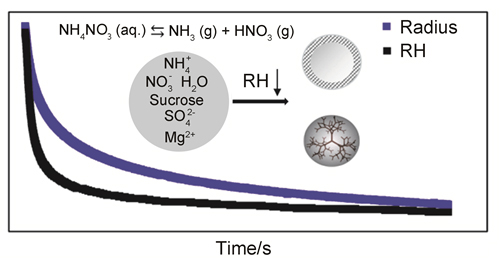[1] Sun, J.; Liu, L.; Xu, L.; Wang, Y.; Wu, Z.; Hu, M.; Shi, Z.; Li, Y.; Zhang, X.; Chen, J.; Li, W. J. Geophys. Res. 2018, 123, 1234.
[2] Zhang, X. Y.; Wang, J. Z.; Wang, Y. Q.; Liu, H. L.; Sun, J. Y.; Zhang, Y. M. Atmos. Chem. Phys. 2015, 15, 12935.
[3] Cai, C.; Tan, S.; Chen, H.; Ma, J.; Wang, Y.; Reid, J. P.; Zhang, Y. Phys. Chem. Chem. Phys. 2015, 17, 29753.
[4] Marshall, F. H.; Miles, R. E. H.; Song, Y.-C.; Ohm, P. B.; Power, R. M.; Reid, J. P.; Dutcher, C. S. Chem. Sci. 2016, 7, 1298.
[5] Hu, M.; Shang, D.; Guo, S.; Wu, Z. Acta Chim. Sinica 2016, 74, 385. (胡敏, 尚冬杰, 郭松, 吴志军, 化学学报, 2016, 74, 385.)
[6] Guo, S.; Hu, M.; Shang, D.; Guo, Q.; Hu, W. Acta Chim. Sinica 2014, 72, 145. (郭松, 胡敏, 尚冬杰, 郭庆丰, 胡伟伟, 化学学报, 2014, 72, 145.)
[7] Hu, D.; Chen, J.; Ye, X.; Li, L.; Yang, X. Atmos. Environ. 2011, 45, 2349.
[8] Chien, W.-M.; Chandra, D.; Lau, K. H.; Hildenbrand, D. L.; Helmy, A. M. J. Chem. Thermodyn. 2010, 42, 846.
[9] Hong, J.; Äijälä, M.; Häme, S. A. K.; Hao, L. Q.; Duplissy, J.; Heikkinen, L. M.; Nie, W.; Mikkilä, J.; Kulmala, M.; Prisle, N. L.; Virtanen, A.; Ehn, M.; Paasonen, P.; Worsnop, D. R.; Riipinen, I.; Petäjä, T.; Kerminen, V.-M. Atmos. Chem. Phys. 2017, 17, 4387.
[10] Lv, X.; Gao, X.; Ma, J.; Zhang, Y. Spectrosc. Spect. Anal. 2019, 39, 1648.
[11] Wang, L. N.; Cai, C.; Zhang, Y. H. J. Phys. Chem. B 2017, 121, 8551.
[12] Krieger, A. A.; Zardini, A. A.; Krieger, U. K. Opt. Express 2009, 17, 4659. |
